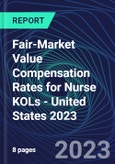Compensation US Nurse KOLs, RNs, NPs, APPs presents fair-market value (FMV) hourly and half-day compensation rates for U.S. KOLs - Nurse, Registered Nurses, Nurse Practitioners and Advanced Practice Providers, by percentiles, with averages, and four (4) levels of Thought Leader influences (rare, international, national and local).
Research shows the Nursing profession is being redefined and is becoming gradually important for Medical Affairs. Nurses, Nurse Practitioners, Registered Nurses and Advanced Practice Providers are increasingly targeted by MSLs and are more and more involved in establishing products at the scientific level. These professionals are at the frontline of care and are being increasingly recognized as one of the best resources for Medical Affairs. Therefore, the need to set up rate cards and fee schedules for this growing category of thought leaders is imperative.
Establishing fair-market value compensation rates will:
- reduce the external perception of inappropriate inducement and limit regulatory and compliance risks.
- provide an independent reference for negotiations with Thought Leaders (KOLs) and Healthcare Providers (HCPs).
- refine and support the development of fee schedules that are aligned with market conditions.
- competitively position the organization and support good business practices.
The data included in each report are an aggregate of collected data and not individual rates. In no event, companies and individuals who provided the data are identified to protect their identity.
The research findings deliver market rates used in the conduct of exchanges with Thought Leaders from 31 life science organizations. Compensation US Nurse KOLs rate card benchmarks help legal, compliance, and medical affair executives refine and support the development of fee schedules that are aligned with market conditions.
Table of Contents
- Use of the publisher's Copyrighted Materials
- Research Methodology
- Definitions
- Therapeutic Area
- Thought Leader Levels
- Hourly Rates
- Flat Rates
Methodology
Analysts use primary and secondary research resources to develop our studies. The quantitative and qualitative data are collected through surveys and interviews conducted with professionals within the area of study. The data presented in our studies are an aggregate of survey and interview input. When possible, the data is presented by country. region or other factor to outline meaningful differences. We protect the identity and privacy of study participants and therefore blind their personal information and the organizations to which they belong - we only present the participation by company size and titles. This enables us to collect unbiased information, provided confidently by participants.

LOADING...








